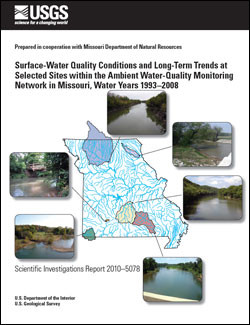
Product Details
- Product Number
- 116748
- Series
- SIR-2010-5078
- Scale
- NO SCALE
- Alternate ID
- SIR-2010-5078
- ISBN
- 978-1-4113-2838-9
- Authors
- JERRI V DAVIS
- Version Date
- 01/01/2010
- Regions
- MO
- Countries
- USA
- Media
- Paper
- Format
- Bound
Additional Details
- Description
-
Abstract
The U.S. Geological Survey, in cooperation with the Missouri Department of Natural Resources, collects data pertaining to the surface-water resources of Missouri. These data are collected as part of the Missouri Ambient Water-Quality Monitoring Network and constitute a valuable source of reliable, impartial, and timely information for developing an improved understanding of water resources in the State.
Six sites from the Ambient Water-Quality Monitoring Network, with data available from the 1993 through 2008 water years, were chosen to compare water-quality conditions and long-term trends of dissolved oxygen, selected physical properties, total suspended solids, dissolved nitrate plus nitrite as nitrogen, total phosphorous, fecal indicator bacteria, and selected trace elements. The six sites used in the study were classified in groups corresponding to the physiography, main land use, and drainage basin size, and represent most stream types in Missouri.
Long-term trends in this study were analyzed using flow-adjusted and non-flow adjusted models. Highly censored datasets (greater than 5 percent but less than 50 percent censored values) were not flow-adjusted. Trends that were detected can possibly be related to changes in agriculture or urban development within the drainage basins. Trends in nutrients were the most prevalent. Upward flow-adjusted trends in dissolved nitrate plus nitrite (as nitrogen) concentrations were identified at the Elk River site, and in total phosphorus concentrations at the South Fabius and Grand River sites. A downward flow-adjusted trend was identified in total phosphorus concentrations from Wilson Creek, the only urban site in the study. The downward trend in phosphorus possibly was related to a phosphorus reduction system that began operation in 2001 at a wastewater treatment plant upstream from the sampling site. Total suspended solids concentrations indicated an upward non-flow adjusted trend at the two northern sites (South Fabius and Grand Rivers). The increase in total suspended solids concentrations could be because of soil erosion from land cultivated for row crops. Most trace element data examined in the study were highly censored and could not be used for flow-adjusted trend analyses.
Water-quality conditions were assessed to explore relations between data from sites and to the State water-quality standards where applicable for selected constituents. Streamflow varied at each site because of drainage area, land use, and groundwater inputs. Dissolved oxygen and water temperature were similar at all sites except the urban site located on Wilson Creek. Specific conductance was similar between the most northern (South Fabius and Grand River sites) and the most southern sites (Current and Elk River sites). Total suspended solids concentrations were near the method reporting level at all sites, except the northern sites. Streams in northern Missouri are more turbid than streams in southern Missouri and are affected by large volumes of sediment deposition because of soil erosion from land cultivated for row crops.
Geometric means of Escherichia coli were calculated from the recreational seasons within the study period. Only the Grand River site exceeded the whole-body-contact standard for frequently used waters. The South Fabius and Grand River sites and the Wilson Creek site had statistically larger densities of both fecal indicator bacteria types than the remaining sites.
- Height In Inches
- 11.000
- Length In Inches
- 8.500
- Two Sided
- Yes
- Pieces
- 1
- Languages
- English



